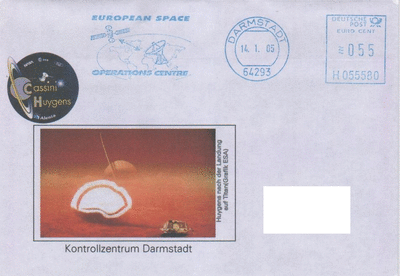Space Cover #438: Cassini-Huygens Tribute, Part 2We are continuing our Cassini-Huygens tribute with a series of covers marking the most significant events and milestones in Cassini's long journey.
The top cover above is another Cassini launch cover, with a cachet showing Saturn and its largest moon, Titan. The bottom cover also marks Cassini's launch, with a Cassini pictorial cancel from Pasadena, CA, the mission's operations center. Of special note is the cover/cachet, as it's an official NASA Exchange and Delaware North Corp. cover, which were available on-site at KSC/CCAFS viewing sites. Ken Havekotte was instrumental in having these covers printed and those shown here are from his collection.

The top cover marks the Cassini fly-by of Saturn's moon Phoebe, with the cachet picturing the rocky moon. The bottom cover marks the Saturn orbit insertion by Cassini-Huygens, with a special Cassini pictorial cancel, and very appropriate use of two USPS Saturn commemorative stamps.

The top cover marks Cassini's first fly-by of Saturn's enigmatic moon Titan, and the cachet pictures early images of that encounter. The middle cover marks the release of the ESA-built Huygens probe/lander, with the cachet picturing Cassini-Huygens linked together prior to separation. The bottom cover marks the historic first landing of probe Huygens on Titan where it transmitted information and photos back to earth for 72 minutes.
Cassini was an international space venture, involving NASA, ESA and the Italian Space Agency, ASI. The mission was managed by JPL and Cal Tech.
This long and amazing odyssey involved and required two gravity-assisted fly-bys of Venus (1998 and 1999), then back to earth for another fly-by (1999) and then by Jupiter (2000), thus supplying the extra velocity required to reach Saturn!
The mission is named in honor of the 17th century French-Italian astronomer Jean Dominique Cassini, who discovered the prominent gap in Saturn's rings, plus four icy moons. The Titan probe/lander, Huygens, was named in honor of Dutch scientist Christian Huygens, who discovered Titan in 1655.















